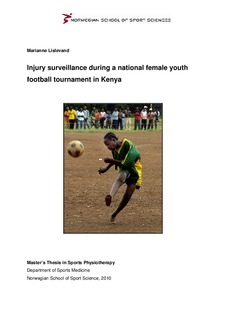| dc.contributor.author | Lislevand, Marianne | |
| dc.date.accessioned | 2010-09-28T12:23:20Z | |
| dc.date.available | 2010-09-28T12:23:20Z | |
| dc.date.issued | 2010 | |
| dc.identifier | Seksjon for idrettsmedisinske fag / Department of Sports Medicine | |
| dc.identifier.uri | http://hdl.handle.net/11250/171512 | |
| dc.description | Masteroppgave - Norges idrettshøgskole, 2010. | en_US |
| dc.description.abstract | Background: Participation of girls in football is growing in Kenya. Football in Kenya is not
only a leisure time activity it is also used as a tool for community and individual development.
Injuries in developing countries are often neglected. Most epidemiological studies on female
youth football players are from Europe or North-America. Epidemiological studies on female
youth football players in Africa are limited.
Objective: To analyze the incidence, characteristics and circumstance of injuries during a
two-day national female youth football tournament in Kenya.
Method: Injuries were registered on a standardized injury report form by specially trained
Kenyan injury reporters. They were supported by four physiotherapist and two doctors.
Injuries were defined as all injuries, painful conditions or physical complaints that occurred
during the match, regardless if the player could continue to play.
Results: A total of 252 injuries were reported from 106 matches. The incidence of all injuries
was 191.2 injuries/1000h [95% CI 167.6-214.8]. Most injuries allowed the players to continue
to play (n=199; 80%). U13 players had an increased risk of injury compared to U16 players
(RR=1.36; 95% CI 1.01-1.84; p=0.043) and O16 players (RR=1.50; 95% CI 1.16-2.11;
p=0.003). Fourteen injuries (6%; 10.6 injuries/1000h; 95% CI 5.1-16.2) were expected to
result in absence from play for at least 1-7 days. The injuries most commonly involved the
lower limb (n= 184; 73%). A contusion to the knee (n=27; 11%) and ankle (n=26; 10%) were
the most common specific injury types. Most acute injuries (188 of 238, 79%) were caused by
player contact.
Conclusion: The incidence of injuries among female youth football players in a national
tournament in Kenya was high. U13 players had the highest injury risk. Contusions to the
knee and ankle were the most common specific injury types. Most of the injured players had
minor injuries and could continue to play, which is positive since football is used to develop
individuals and communities. | en_US |
| dc.language.iso | eng | en_US |
| dc.subject | fotball | en_US |
| dc.subject | Kenya | en_US |
| dc.subject | kvinner | en_US |
| dc.subject | skader | en_US |
| dc.subject | ungdom | en_US |
| dc.title | Injury surveillance during a national female youth football tournament in Kenya | en_US |
| dc.type | Master thesis | en_US |
